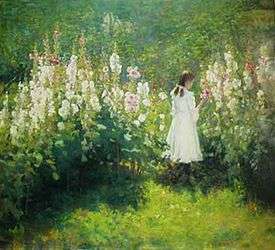John Hafen

(date unknown, 1890s?)
John Hafen (March 22, 1856, Scherzingen, Switzerland - June 3, 1910, Brown County, Indiana) was an American landscape artist. In 1890, he was one of a group of painters who studied in Paris under the sponsorship of The Church of Jesus Christ of Latter-day Saints (LDS Church), in preparation for painting murals at the nearly completed Salt Lake Temple.
Biography
His family converted to the LDS Church and emigrated to the United States when he was six, making the journey from Omaha to Utah by ox team.[1] Originally they settled in Payson, but moved to Salt Lake City in 1868, so he could attend school. He was enrolled at the 20th Ward Academy, where one of his teachers was Karl G. Maeser.[2]

Drawing was one of the subjects taught there, and he displayed an early talent for art. Over the next ten years, he was tutored by George M. Ottinger and Dan Weggeland; instructors at the University of Deseret (now the University of Utah). He also learned photography and worked as an assistant to George Edward Anderson.[3] In 1881, Hafen and a group of young artists founded the Utah Art Association, organizing exhibitions and providing art instruction.[2]
In 1890, he convinced the LDS Church leadership to sponsor art studies in France. Together with John Fairbanks, Lorus Pratt and Edwin Evans, Hafen was awarded a two-year scholarship to study at the Académie Julian in Paris, where their primary instructor was Albert Rigolot, and they became known as the "French Art Missionaries". While there, his first experiences with plein air painting (and, perhaps, memories of his father, who was a gardener) encouraged him to devote himself to landscapes.[1] Due to family financial difficulties, he had to return after only one year and was the first of his group to begin work at the Temple, playing a major role in the initial mural planning.[3]
Financial difficulties
In 1893, after the temple was consecrated, he rejoined the Utah Art Association and served as Vice-President. He wasn't able to support his wife and ten children by painting, however and, by invitation from Benjamin Cluff, taught art at the "Brigham Young Academy"[2] (precursor to the University), while continuing to receive $100 per month to paint for the Church. Many of his works are now part of the collection at the Museum of Church History and Art.[3]

Although too poor to pay his rent, by trading a painting for the right to use some land and bartering with locals for help with the construction, he was able to acquire a home in Springville; a Swiss-style chalet, designed by his friend Alberto Treganza.[1] It is now in the National Register of Historic Places as the "John Hafen House". He donated many paintings to Springville High School and encouraged other artists to do the same. The collection grew to the point that it required a separate building and formed the nucleus for the Springville Museum of Art.[2]
In 1908, still struggling financially, he moved to Indiana to work with the Hoosier Group (an informal association of Impressionist landscape artists) and achieved wider recognition, including a commission to paint Governor Thomas R. Marshall's portrait. His success was short-lived, however, as he died from pneumonia in 1910.[1]
References
Further reading
- Conant, William Lee Roy, Jr. (August 1969), A Study of the Life of John Hafen: Artist With an Analysis and Critical Review of His Work (Master's thesis), Provo, Utah: Department of Art, Brigham Young University.
- Robert Olpin, Thomas Rugh; Painters of the Wasatch Mountains, Salt Lake City, Gibbs Smith, Publisher, 2005 ISBN 1-58685-850-5
- Robert Olpin, Donna Poulton, Vern Swanson; Utah art, Utah artists : 150 year survey, Layton, Gibbs Smith, 2001 ISBN 1-58685-111-X
- Florence, Giles H., Jr., "Harvesting the Light: The 1890 Paris Art Mission", Ensign
External links
| Wikimedia Commons has media related to John Hafen. |
- "Rare Salt Lake Temple garden room painting found" by Michael Ann McKinlay, from the Deseret News (2011)
- John Hafen @ Find a Grave
- Finding aid author: Andrea Wyss (2013). "John Hafen papers". Prepared for the L. Tom Perry Special Collections, Provo, UT. Retrieved May 16, 2016.